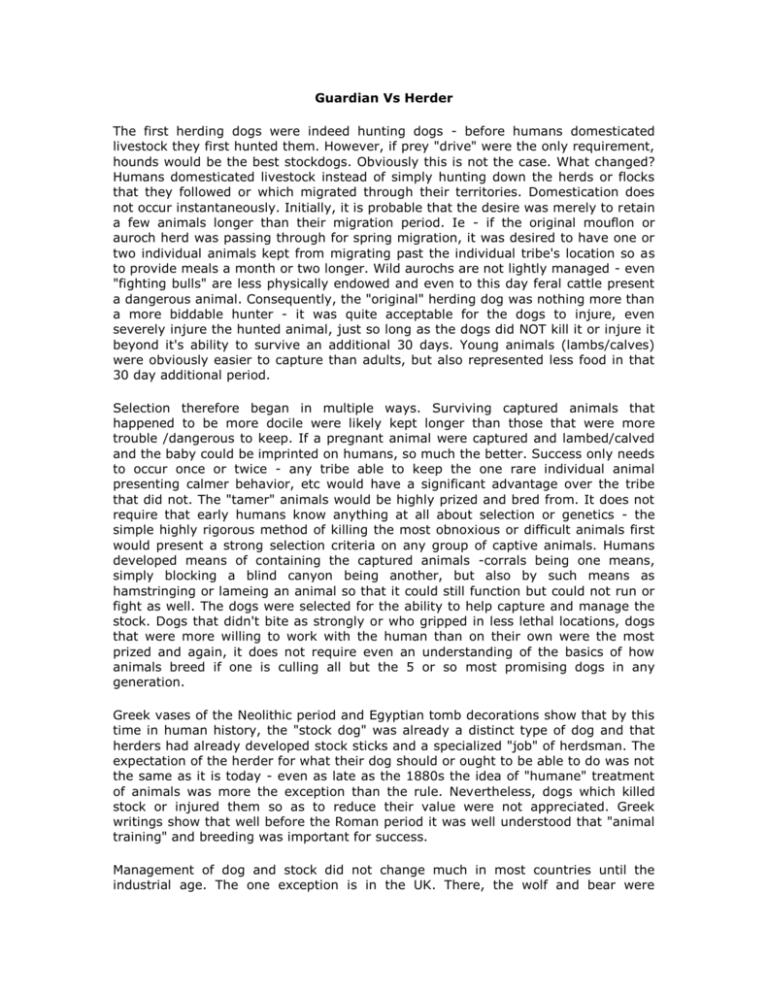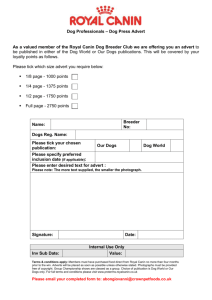
Guardian Vs Herder
The first herding dogs were indeed hunting dogs - before humans domesticated
livestock they first hunted them. However, if prey "drive" were the only requirement,
hounds would be the best stockdogs. Obviously this is not the case. What changed?
Humans domesticated livestock instead of simply hunting down the herds or flocks
that they followed or which migrated through their territories. Domestication does
not occur instantaneously. Initially, it is probable that the desire was merely to retain
a few animals longer than their migration period. Ie - if the original mouflon or
auroch herd was passing through for spring migration, it was desired to have one or
two individual animals kept from migrating past the individual tribe's location so as
to provide meals a month or two longer. Wild aurochs are not lightly managed - even
"fighting bulls" are less physically endowed and even to this day feral cattle present
a dangerous animal. Consequently, the "original" herding dog was nothing more than
a more biddable hunter - it was quite acceptable for the dogs to injure, even
severely injure the hunted animal, just so long as the dogs did NOT kill it or injure it
beyond it's ability to survive an additional 30 days. Young animals (lambs/calves)
were obviously easier to capture than adults, but also represented less food in that
30 day additional period.
Selection therefore began in multiple ways. Surviving captured animals that
happened to be more docile were likely kept longer than those that were more
trouble /dangerous to keep. If a pregnant animal were captured and lambed/calved
and the baby could be imprinted on humans, so much the better. Success only needs
to occur once or twice - any tribe able to keep the one rare individual animal
presenting calmer behavior, etc would have a significant advantage over the tribe
that did not. The "tamer" animals would be highly prized and bred from. It does not
require that early humans know anything at all about selection or genetics - the
simple highly rigorous method of killing the most obnoxious or difficult animals first
would present a strong selection criteria on any group of captive animals. Humans
developed means of containing the captured animals -corrals being one means,
simply blocking a blind canyon being another, but also by such means as
hamstringing or lameing an animal so that it could still function but could not run or
fight as well. The dogs were selected for the ability to help capture and manage the
stock. Dogs that didn't bite as strongly or who gripped in less lethal locations, dogs
that were more willing to work with the human than on their own were the most
prized and again, it does not require even an understanding of the basics of how
animals breed if one is culling all but the 5 or so most promising dogs in any
generation.
Greek vases of the Neolithic period and Egyptian tomb decorations show that by this
time in human history, the "stock dog" was already a distinct type of dog and that
herders had already developed stock sticks and a specialized "job" of herdsman. The
expectation of the herder for what their dog should or ought to be able to do was not
the same as it is today - even as late as the 1880s the idea of "humane" treatment
of animals was more the exception than the rule. Nevertheless, dogs which killed
stock or injured them so as to reduce their value were not appreciated. Greek
writings show that well before the Roman period it was well understood that "animal
training" and breeding was important for success.
Management of dog and stock did not change much in most countries until the
industrial age. The one exception is in the UK. There, the wolf and bear were
exterminated relatively early in history in both Britain and islands such as the
Shetlands. Other predators such as Lynx and even lions (who may have existed in
some parts Europe as late as the roman period) were eliminated even earlier.
Consequently, dogs were not needed to protect against four footed predators other
than other dogs and the occasional fox. The "black death" and subsequent
"enclosure" of land for raising sheep created a unique situation in some areas where
dogs were used primarily to bring in sheep that had been left on their own for
months at a time. This obviously does not apply to dairy animals and there, as in
Europe, the dog was still required to work stock on a daily basis and that stock had
to be kept close. In the "new world" the same situation applied as in general Europe.
Consequently, in accounts dating as late as Von Stephanitz' book The German
Shepherd in Word and Picture, in books like Gilfllan's "SHEEP, life on the Dakota
range" (written in 1927) and in America's sheep trails, etc, the general requirement
of the herding dog is more or less unchanged - it has, by simple selection over 3,000
years (the period from Neolithic to modern) become more skilled and sophisticated,
but the dog is still required to contain and manage the stock and "roughness" with
stock that are not cooperating was in general well tolerated. As Von Stephanitz' book
shows, use of mechanical means (filing teeth, muzzles, knocking out teeth) to
control dogs from being TOO rough were used but also there is obviously an
incentive for selecting dogs that use only appropriate force - one has more animals
that are in better condition with a dog that doesn't injure them.
When did herding trials first start? Probably when the first two herders tried to brag
who had the best dog. Formal trials started in England in the 1840s and in Europe in
the 1880s. The "ISDS" course used in the UK became a major selection tool for the
dogs and thus is responsible for the modern border collie as we know it today.
Industrialization and a consequent change in how livestock were managed meant
that many breeds became obliterated or drastically changed - it was no longer
necessary to take one's dairy herd 20 miles to a market and therefore a dog that did
this was no longer necessary. The rise in population and the beginning of the
"conformation" dog exhibition also drastically changed many dogs - breeds were
either obliterated, modified or combined to create breeds that had not existed as
actual working breeds and in many breeds, the percentage of dogs that represented
the working lines became the tiny minority. This accelerated in a quantum fashion in
the 20th century - the % of Australian Shepherds used in farms/ranches being
drastically smaller in 1999 vice the % that had done so in 1900. The creation and
increased popularity of herding "trials" began selection for dogs that were "sport"
dogs rather than actual working dogs - in many cases the functions were very
compatible but not always - a trial dog needed to give it's "all" in a 10 or 15 minute
"run" whereas a working ranch dog was expected to remain functional for hours and
days in succession. Trials generally had a single "type" of test - in terms of the tasks,
the stock, and even the # of stock presented whereas each individual farm or ranch
might have very different numbers, tasks or mixed stock.
Currently, only a small % of "herding" dogs actually herd. Of these, a smaller group
is primarily selected for breeding based on their ability to herd. And of these, only a
fraction are tested and selected based on actual ranch or farm work as compared
with success at "sport" trials. This change, starting in the 1840s, has in the past 200
years, meant that the dogs themselves have altered. Wither for the good or the bad
or some of both remains to be seen.
Two types of livestock guardian
There is often a misconception on the role "herding" dogs such as the Belgian,
Bouvier, Australian Shepherd etc played vice that of the "guardian" dogs such as the
Kuvaz, Great Pyrenees, Komondor, etc. The reason there seems to be confusion is
the assumption that "guarding" livestock always means the same thing and that the
dogs must have the same type of temperament in order to accomplish the job of
"guarding". This is not the case. There are, in fact, TWO distinct methods which were
used in guarding livestock.
The first is the one that is most commonly thought of today and which is considered
the most "classic" is the one that is played by the Kuvaz, Great Pyrenees, Komondor,
etc. In this case the dog is brought up among the livestock and is expected to defend
the flock or herd as if it were a member of the group. In these cases, the dog is
often introduced to the flock/herd as a very young puppy - during the socialization
phase of the canine - and kept with the flock/herd as much as possible. Human
interaction is often minimal and the dog associates the herd/flock as it's "pack".
Accounts of this method often stress that the dog is NOT the dominant member of
the group and often describe instances of individuals of the livestock in question
dominating or "bullying" the dog. The dogs are intended to be territorial and to warn
or drive off intruding canines or other predators. At least some accounts indicate the
guardian dogs are working in a DEFENSIVE mode - they don't want to leave their
"pack" (ie the herd/flock) and so respond to threats that intrude on the group's
territory. Such dogs are generally speaking similar in color to that of the stock they
are used to protect (ie white dogs with white-fleeced sheep, etc) and usually such
dogs are large in size (80 pounds or more, usually more).
In contrast herding dogs are expected to control stock and maneuver them and there
is often a great deal made of a requirement for such dogs to be very predatory
towards the stock they are employed to manage. There is often an assumption that
"herding" is thus incompatible with "guarding". What then to make of accounts of
breeds such as the Bouvier, Belgian Sheepdog, Beauceron etc, "protecting" their
flock? Some people have concluded that if the old accounts have such dogs
protecting the flock then such dogs could not have been "true" herding dogs.
This is only true if one is to presume that the only way the dogs can function in this
role is to be the same in temperament and mind set as the Kuvaz, Komondor, etc.
This is not true. In herding dogs, the first association of the puppy is with the
HUMAN. The dog is associated with humans as its pack members and to consider the
human handler as the "alpha" in the pack. All other pack members (human or
canine) are more or less considered "subordinate" to the lead human. This includes
the livestock. In early human history, livestock was not separately contained - even
as late as medieval periods, the livestock were most often in the lower part of the
same building where the humans lived - if they were not simply on one side of the
same living quarters. Consequently, the herding dog was bred and managed so as to
associate the human AND livestock as the same "pack", with the human as the alpha
leader. The dogs were generally selected not so much for predatory behavior but to
MANAGE and CONTROL the livestock. In other words, the herding dog must
dominate the herd or flock. It may do so using predatory means or it may do so
using "pack dominance" means or a combination of the two.
So what about guarding? Wolves protect their pack members and particularly their
puppies. A herding dog was not, in general, left alone to protect the flock. The dog
was not selected or desired to think of itself as "one of the flock" and thus protect
the flock. Instead the dog was desired to think of the stock POSSESSIVELY - these
are "MINE", almost in the same way as a wolf will defend it's pups while dominating
and disciplining and controlling them. The herding dog only accepts the herdsman as
alpha over the dog, and considers itself dominant over the herd/flock. In general the
herdsman was present and the dog was used to warn and to assist the herdsman to
protect the flock. In Europe, because most peasants were not allowed to have any
more effective weapon than a herding crook (and possibly a slingshot), the dog had
to be big enough to persuade both four footed and two footed predators that it was
easier to "pick on the guy down the street". A dog therefore had to be big enough to
take on a predator with the handler assisting. Most wild predators are, incidentally,
easier to persuade than would be the deserting soldier from Napoleon's army. Guns
were not particularly effective until the 1860s when the rifled barrel became common
and a single shot gun (the repeating rifle is also of relatively late development as is
the revolver) and were extremely rare and expensive - most peasants did not own
one. In the UK, most of the larger predators were exterminated in the 1700s (the
last wolf, bears, etc) and while drover dogs like the OES were used to protect the
flock/herd on a trek to the market, there seems to have been less demand for a
"protective dog" because in most cases the UK feudal system ensured that any
"bandit" would likely meet the local sheriff or the local baron and armsmen.
In the US, the situation is slightly different. First, the stock were not allowed to
"roam" - predators were very prevalent and most of the country was "unknown
territory". So there was less need for a guardian breed. The second major factor was
that from Columbus on, the use of firearms by those using stockdogs was almost
universal. By the end of the Civil War the existence of rifled barrels and repeating
guns ensured more accurate weaponry and the general population was well versed in
their use. Therefore a dog was not needed to "take on" either a 4 footed or 2 footed
predator on it's own. The dog was needed to give an alarm and to "delay" the
predator long enough for the herdsman to use a gun. This is, IMO, the fundamental
reason why the Australian Shepherd, which is the primary American stockdog, is a
smaller dog than say, a Beauceron or Belgian Sheepdog. They have much the same
attitude and willingness to "defend" but are not built to do "man work".
Where the dog works stock daily, a "predatory" mode becomes less effective - the
stock either decide that the dog "really doesn't mean it" or they are perpetually
nervous around the dog. Greater success is achieved where the dog acts as a
dominant pack member and the stock are controlled by a dog that "disciplines" the
stock in the same manner as it might subordinate pack members. In these cases,
the stock learn to trust the dog as a leader - as long as they comply, the dog will not
harm them. Both sheep and cattle have "herd leaders" and this behavior
characteristic is therefore hardwired into the herd/flock. Selection for compliance on
the stock's part and effectiveness on the dog's part has resulted in a highly effective
method of controlling the stock.
However, where the stock are generally left on their own and the dog must collect
and manage them on an "instants" notice, the predatory mode works much better
than a management method. This is because all prey animals instinctively respond to
a "I am hunting you" behavior whereas it requires time and familiarity for stock to
trust a dog using the "management technique" This is, fundamentally, the difference
between types of stockdogs - the "eye" TENDS to be more prevalent in the prey
mode dogs but it is not necessarily exclusive. It is likely that there are some
functional advantages to "eye" in a prey type dog as the "stalking fox" mode of
approach is very stylized and therefore very obvious to a prey animal (see the
studies on cardboard "hawks" and chickens to see why this is). However a strongly
predatory mode dog will have trouble getting stock to be calm or settled in close
quarters just as the stock are nervous when a predator like a wolf or mountain lion
were nearby - the stock do not "trust" the dog not to hurt them.
As to which is best, it entirely depends on what one wants. But use of one or the
other indiscriminately often persuades people that they don't want a dog at all, and
use of one in a manner more suited to the other often results in the individual
deciding that "that breed" can't work stock. It is more a case that one has attempted
to use a Porsche as a towing vehicle or a truck as a race car.
© 2005 Peggy Richter. All rights reserved. No reproduction of this article is permitted
without permission of the author.




